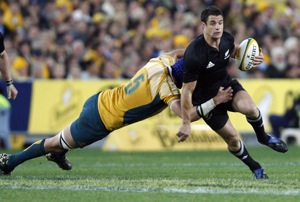
New Zealand's Dan Carter, right, is tackled by Australia's Nathan Sharpe during the Bledisloe Cup rugby match in Sydney, Australia, Saturday, Aug. 22, 2009. New Zealand won the match 19-18 and retain the Bledisloe Cup.(AP Photo/Rob Griffith)
There have been disparaging comments from the usual suspects in the British rugby media suggesting that the Bledisloe Cup Test in Tokyo is a commercially-oriented nonsense. Nonsense to that, I say.
Whenever Australia plays New Zealand at rugby, it is a good thing for the game, for supporters of the teams, for the lucky people who get to watch it live or on television, and for spreading the rugby gospel around the world.
Ever since 1903, the Wallabies and the All Blacks have been smacking into each other on the rugby field in contests that have stirred the tribal blood of their supporters in both countries.
What’s the problem with having four of these intense contests?
In 1962 there were no fewer than five Bledisloe Cup Tests played, two in Australia (NZ 20-Australia 6, NZ 14-Australia 5) and three in New Zealand (NZ 9-Australia 9, NZ 3-0, NZ 16-Australia 8. )
The scorelines indicate that the Wallabies got better (at least at contesting Tests with the All Blacks) as the series split over two-nations continued.
The next year, 1963, the Wallabies indicated how much the stern contests had toughened them up when they defeated England convincingly at Sydney 18 – 9, and then by winning two Tests, back-to-back, in a four Test series in South Africa.
These victories in the second and third Tests of the 1963 tour of South Africa, at Capetown and Johannesburg, represent one of the finest achievements of a Wallabies touring side. No All Blacks side had managed to achieve the back-to-back victories until 1996.
It is not being far-fetched to say that the fact of very frequent Tests between Australia and New Zealand has been a key factor, the key factor perhaps, in Australia and New Zealand being top tier rugby nations for over 100 years.
The playing numbers in New Zealand and Australia are a fifth of what they are in England and South Africa, yet both the nations have been more than competitive against their numerically-superior opponents.
More often than not, New Zealand rugby has been the engine that has pushed the Australian game forward.
But from time to time, and more frequently in the last 30 years, great Wallaby sides (1984-86, 1991-1994, 1999-2001) have forced the All Blacks to lift their game to stay in the game.
An example of this was last year’s defeat of the All Blacks by the Wallabies at Sydney, in the first Bledisloe Cup/Tri-Nations match of the year and Robbie Deans’ first time as Wallaby coach in these tournaments.
The Wallabies thrashed an All Blacks side that tried to run the ball from inside its own 22 before establishing any forward dominance. The All Blacks coached learned from the thrashing and the team went on to win the Tri-Nations and complete a Grand Slam on their European tour later in the year.
Now it is the Wallabies who have do the learning.
They have not defeated the All Blacks since that Sydney triumph. When Deans was asked in Tokyo to explain some of his selection decisions (George Smith on the bench, Digby Ione on the wing, Ryan Cross at centre, Matt Giteau at first five-eighths), he said they had to find a way of defeating the All Blacks.
The touring ethic, playing in other countries, is part of the zen of the rugby union game.
NSW was the first provincial side in the world to tour another country, New Zealand, in 1882.
The only team so far included in the IRB’s Rugby Hall of Fame is the 1888/89 New Zealand Natives side which played 107 matches in New Zealand, Australia, and the United Kingdom.
In 1904, Te Aute College sent a rugby team to Sydney, the first schoolboys side to tour another country. This side won all its matches (including a defeat of St Joseph’s at Hunters Hill) and played so expansively and skilfully that it has been suggested that the famous Joeys style is derived from the Te Aute system.
The fourth Bledisloe Cup Test in Tokyo is entirely in this touring spirit.
Two of the best sides in the world are taking their games to the rugby community in Japan to give these stalwarts the chance to see players like Richie McCaw and Matt Giteau, who they have idolised from afar.
At the main press conference with the two teams and their coaches, there were over 200 media persons. The conference went on for over 90 minutes (questions and answers had to be translated) provoking the laconic Deans to remark after one short reply took some time in translation: “I didn’t realise I was so verbose.”
It is expected that the 40,000-seat stadium will be close to full, despite the astronomical prices being demanded by the organisers of the event, Dentsu, the world’s biggest advertising agency.
All this publicity and the Test itself will raise the profile of rugby in the region in the run-up to the 2019 Rugby World Cup in Japan, and help bring more youngsters into playing the game.
And not only in Japan.
The 13th biggest rugby franchise in the IRB nation, apparently, is Malayasia, where there are 35,000 players.
The NZRU is bringing over Sir Peter Snell, the Olympic champion in 800m and 1500m at the Tokyo Olympics in 1964, to mark the occasion, which in rugby terms is an epoch event in spreading the gospel in Asia.
Bring it on!





























































































